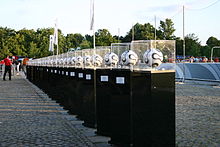Adidas Teamgeist
The +Teamgeist ball was the official football for the FIFA World Cup 2006. The plus sign in its name was introduced for trademark purposes, since the regular German language word Teamgeist, meaning "team spirit", could not be trademarked.
The ball was designed by the Adidas Innovation Team and the Molten Corporation and is made by Adidas, which has provided the balls used in all World Cup matches since the 1970 World Cup when the Telstar was introduced. The Teamgeist ball differs from previous balls in having just 14 curved panels (making the ball topologically equivalent to a truncated octahedron), rather than the 32 that have been standard since 1970. In another first, the panels are bonded together rather than stitched. It is claimed to be rounder and to perform more uniformly regardless of where it is hit, and being almost waterproof it does not change performance as much when wet.
Each of the 32 qualified federations received 40 match balls for training purposes.
Match balls

Match balls for the 2006 FIFA World Cup were personalized with the name of the stadium, the teams, the match date and the kick-off time of each individual game, under a protective coating.
A special match ball was used for the final game—the "Teamgeist Berlin". The design is the same as the other match balls, but accented in gold, with black and white details. Both qualified federations (France and Italy) received 20 of these versions for training purposes.
Technical specification
Although it had been planned to include an electronic tracking system in the ball, this was abandoned after a trial at the 2005 World Under-17 Championship in Peru.
| FIFA Approved standard[1] | Teamgeist measurements[1] | |
|---|---|---|
| Circumference | 68.5 – 69.5 cm | 69.0 – 69.25 cm |
| Diameter | ≤ 1.5% difference | ≤ 1.0% difference |
| Water absorption | ≤ 10% weight increase | ≤ 0.1 % weight increase |
| Weight | 420 - 445 g | 441 - 444 g |
| Shape and size retention | 2000 cycles at 50 km·h−1 | 3500 cycles at 50 km·h−1 |
| Rebound test | ≤ 10 cm | ≤ 2 cm |
| Loss of pressure | ≤ 20% | ≤ 11% |
Development
The introduction of a 14-panel construction method means that the number of three-panel touch points is reduced by 60 percent (60 to 24) and the total length of the panel lines falls by over 15 percent (400.5 cm to 339.3 cm). Building on the introduction of thermal bonding technology in 2004, the Teamgeist ball is the first time Adidas have used this in a World Cup. Loughborough University conducted extensive comparative testing on the ball, along with the Adidas football laboratory in Scheinfeld, Germany.[2]
Other versions

A version of Teamgeist, the Teamgeist MLS, is used in the USA/Canada in Major League Soccer as of 2006. It is similar to Teamgeist, but the details are in the MLS' official colours of blue and green. Also, the +Teamgeist Winner MLS matchball, which was used in the 2006 MLS Cup, and the league's grand champion's home games in the 2007 MLS season, is chrome silver metallic, trimmed in white, black, and royal blue.
Another version, the Teamgeist RFEF, is used in the 2006 Copa del Rey Final; it is red and yellow. The Teamgeist League is red, yellow, and black with white trim and is used in various leagues.
In France's Coupe de France, the +Teamgeist FFF matchball is chrome silver with royal blue trim.
In Argentina, the Teamgeist Argentine Football Association matchball for 2007 is a navy blue and white with black trim and will be used through the 2007 Argentine Clausura.
Also in 2007, the FIFA Women's World Cup +Teamgeist matchball will be blue and red with white trim.
There is also the "Wawa Aba", the official Africa Cup of Nations Ghana 2008 match ball, which is red, yellow and green in colour being derived from the national flag of the African Cup of Nations host nation, Ghana.[3]
"Official replicas" of the Teamgeist have its 14-panel pattern superimposed on a lower specification 26-panel ball.
Criticism
While Johann Vogel and David Beckham and others were reported to be happy with the new ball, it was criticized by many top players before the World Cup.
The Albanian National Team claim to have lost most of their games because many of the games were played with this ball.[citation needed]
Other players include Brazil's Roberto Carlos[4] and Paul Robinson of England.[5] They claimed the ball was too light and had a vastly different performance when wet. The ball has fewer seams, reducing air resistance.
The "Wawa Aba" was criticised by MVP Egyptian midfielder Hosni Abd Rabou who said that ball was bad for passing.[6]
See also
References
- ^ a b Teamgeist at Soccerballworld
- ^ http://www.lboro.ac.uk/service/publicity/news-releases/2005/116_adidas.html adidas unveils the match ball for the 2006 FIFA World Cup - tested at Loughborough University [Accessed 28 September 2008]
- ^ http://www.footy-boots.com/adidas-wawa-aba/ ADIDAS “WAWA ABA” : AFRICAN CUP OF NATIONS BALL [Accessed 28 September 2008]
- ^ Sports: Champs: New ball falls flat
- ^ The balls are awful says Robinson, but luckily I've had some practice | World Cup 2006 | Guardian Unlimited Football
- ^ http://nationscup.mtnfootball.com/live/content.php?Item_ID=13453 MTNfootball.com - MTN Africa Cup of Nations - Hosni Abd Rabou Exclusive [Accessed 28 September 2008]
